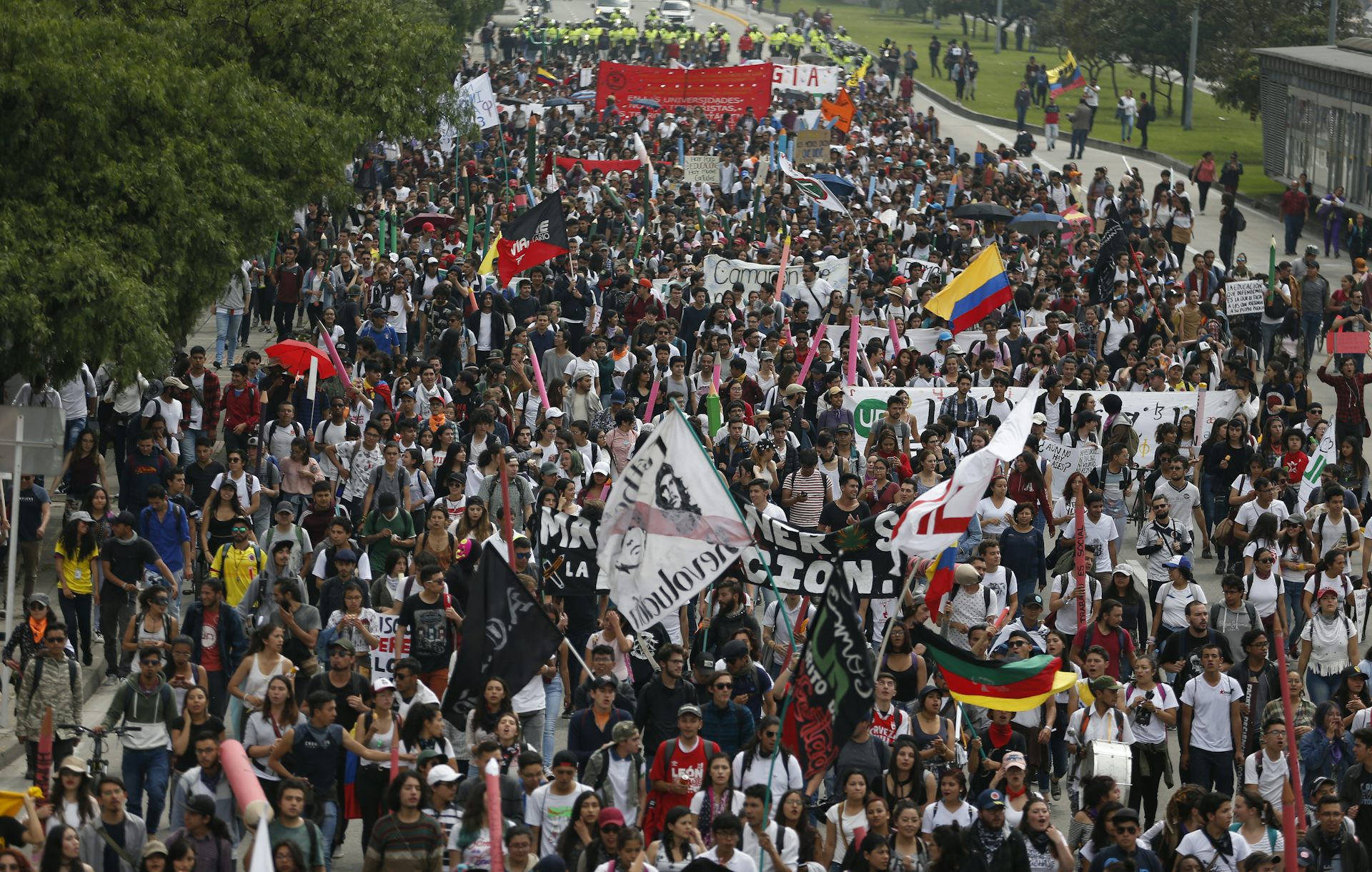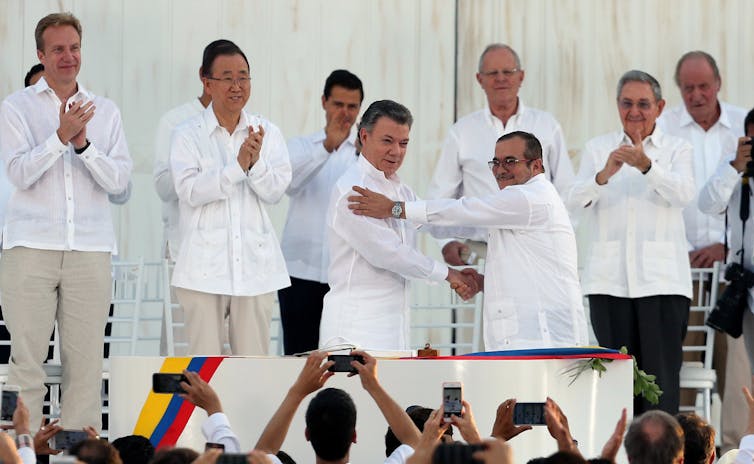
Ivan Duque has only been Colombia’s president since August, but already his government is in crisis.
The country that has been gripped by near-constant protest since the 42-year-old conservative took power. But the mass demonstrations that criticize Duque’s young government may actually be a good sign for Colombian democracy.
Duque, who has never before held elected office, pledged that his government would “correct” the perceived mistakes of the centrist former president Juan Manuel Santos, who left office after eight years with 19 percent public support.
Voters blamed Santos for failing to reign in corruption, allowing Colombia’s economy to stagnate and signing an unpopular peace treaty with the country’s main guerrilla group. Now, as Duque recently acknowledged on Twitter, they are angry that his floundering government has struggled to deliver on any campaign promises in its first 100 days.
Protests grip Colombia
Duque’s economic reform package, which proposed tax exemptions for industrial developers and a tax hike on food, was seen as pro-business and anti-poor. The government is also feeling the fallout of the massive Odebrecht corruption scandal that has implicated high-ranking public officials across Latin America, including in Colombia.
The president’s approval rating plummeted, from 47 percent in October to 27 percent in November. Meanwhile, the number of street protests has more than tripled since Duque took office, according to an analysis by the think tank Fundación Ideas para la Paz.
Students and school teachers have demonstrated to demand higher public education investment, better teacher pay and improved educational access nationwide. Their marches have been joined by indigenous groups, who express solidarity with the students and demand an autonomous indigenous education system.
Coca-leaf growers have marched in different provinces, protesting the government’s renewed focus on eradicating their illicit crop rather than on helping farmers plant substitutes like cacao and coffee.
And Colombian truckers went on strike over what they say are excessively high fuel, VAT and toll prices in late November, demonstrations that now risk paralyzing commerce.
Ending Colombia’s armed conflict
In Colombia, a protest movement with so much power and stamina is not necessarily a bad sign. As a scholar of peace and conflict, I see these public displays of dissent as proof that peace is effectively taking hold in Colombia after decades of bloody violence.
The Colombian conflict, which began in the late 1940s and continues today, is one of the world’s longest-running armed struggles. It involves the Colombian armed forces, leftist guerrillas seeking to overthrow the state, drug lords who control huge swaths of territory and right-wing paramilitary groups.
Clashes between these factions – which have included bombings, firefights, kidnappings and targeted assassinations – have killed more than 1 million civilians since 1985 and given Colombia the world’s second-largest displaced population.
In late 2016, after a lengthy negotiation, President Santos signed a controversial treaty with the Armed Revolutionary Forces of Colombia, or FARC guerrillas.
The FARC was the biggest and most tenacious player in Colombia’s conflict, with around 7,000 troops stationed across the country. Disarming these Marxist revolutionaries was an important step toward deescalating violence and convincing other armed groups to enter talks with the government.

The Colombian government has faced numerous hurdles to fully implementing the agreements it made with the FARC, and many Colombians reject negotiating with terrorists entirely. Skirmishes continue, and a spate of activist killings has international observers worried.
Peace is still fragile.
Nonetheless, the year after the accord came into effect, on Nov. 30, 2016, FARC fatalities declined from 3,000 to 78, Colombia’s murder rate dropped to a historic low, and attacks by armed groups declined 52 percent.
Peace stretches its wings
The current protest movement is another consequence of Colombia’s new peace.
During the FARC’s 52-year insurgency, social movements in Colombia were frequently accused of being an extension of the guerrilla group or of being infiltrated by its members. That allowed public officials to discredit protesters as terrorists and ignore their demands.
The FARC accord changed that.
For the first time in its modern history, there’s room for dissent in Colombia.
Politicians from the left and right now openly support the marches organized by students, teachers, coca-growers, indigenous people, Afro-Colombians and trade unions. Political backing gives protesters more legitimacy and shields them from possible police repression – previously a common response to non-violent and violent protests alike.
Police protection, not repression
National policing reforms passed in 2016, which sought to safeguard the constitutional right to protest in Colombia, have also led to a more restrained response by law enforcement.
When marches shut down city streets and snare traffic, Colombian riot police typically escort and protect protesters, rather than confront them. On the last day of a student strike in October, officers in the town of Popayán even gave protesters flowers.
Confrontations between Colombian police and protesters still occur, sometimes violently.
On Nov. 11, as officers in riot gear arrested students during a massive education march in Bogota, video footage appears to confirm protesters’ allegations that plainclothes police threw stones at the officers to incite violence.
Colombian police seem to use force more often in confronting rural marches by indigenous, Afro-Colombian and peasant protesters, my analysis shows. In part, that’s because the 2016 police reforms – like most government initiatives in Colombia – have been more fully adopted in the capital and other major cities.
Urban protesters also have better access to the legal and PR help they need to hold law enforcement accountable for abuse, and their causes tend to enjoy more political support.
Police are not the only ones changing their protest tactics in the new Colombia.
Colombians dance at a protest in the main square of Bogota on Nov. 11 (Katherin Ayala/Facebook)
Advocacy groups have demonstrated creative, peaceful forms of protest, using art, dance and music to convey their message. Most explicitly reject violence as a strategy.
In a country where for so long dissent was met with repression, stigma and accusations of terrorism, these vibrant protests are signs of positive change indeed.![]()
Fabio Andres Diaz, Researcher on Conflict, Peace and Development, International Institute of Social Studies
This article is republished from The Conversation under a Creative Commons license.

